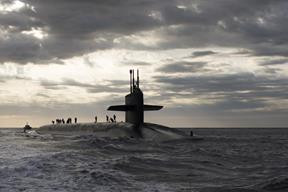Amid an intensified global submarine arms race, China has made a landmark move, marking its debut in the nuclear-powered guided missile submarines sector, according to a recent Pentagon report. These developments, while posing fresh challenges for U.S. and other Indo-Pacific militaries, have curiously left Kremlin unfazed, emphasizing its robust strategic ties with Beijing.
The Pentagon's report, released on Oct. 20, seems to confirm earlier speculations from May 2022 when Reuters uncovered satellite images suggesting that China's Huludao shipyard was crafting a new or enhanced submarine model, potentially equipped for launching cruise missiles. This development further solidifies the notion that the submarines observed over the past year and a half in Chinese shipyards are indeed Type 093B guided missile submarines.
"The Chinese navy, in the near future, will possess the capability to conduct extended precision strikes against terrestrial targets utilizing land-attack cruise missiles from both its submarines and surface combatants," the report detailed, emphasizing a significant amplification in China's power projection capability.
Historically, conventionally armed missile submarines, or SSGNs, were crafted during the Cold War by the Soviet Union with a strategic focus on targeting U.S. aircraft carriers. The U.S., not to be outdone, pivoted its ballistic missile vessels to support a substantial number of land-attack Tomahawk cruise missiles. "The USS Florida's 93 Tomahawk launches against Libyan air defenses in 2011 serves as a prominent combat demonstration from a U.S. SSGN," mentioned an Asian military attaché.
Collin Koh, a Singapore-based security scholar, commented on China's advancements, "With the core armament likely being cruise missiles, these submarines can potentially execute saturated land and anti-ship attacks from a distance, reshaping strategic considerations for China's adversaries."
The Pentagon's report has a more startling prediction: three such SSGNs could be operational by the upcoming year. By 2025, China's naval expansion might feature 65 submarines, both nuclear and diesel-powered.
Amid these escalations, Russia's response has been peculiarly composed. Kremlin spokesman Dmitry Peskov stated, "We harbor no concerns; our ties with China represent an advanced strategic partnership. China is merely taking measures it deems fit to secure its regional interests." He later highlighted China's "absolute sovereign right" in these pursuits.
This comes as Russia cultivates an even closer "no limits" alliance with China, bolstered after Western sanctions following Moscow's military movement in Ukraine in February 2022. While Russia has recently adjusted its nuclear policy, it pledges not to recommence nuclear tests unless the U.S. initiates.
As the U.S. Naval War College research has underscored, the PLA may be on the cusp of engineering nuclear-powered submarines that are stealthier and more challenging for allies to monitor. However, whether these advancements are incorporated in the recently revealed SSGNs remains ambiguous.
An unnamed Asian military attaché observed, "While the initial deployments may be approached with caution by the PLA navy, it's evident that under Xi Jinping's directive, the submarine force is ascending to priority status."
As China steadily advances its naval arsenal and Russia remains confidently indifferent, the power dynamics in the Pacific region appear poised for significant recalibration.






